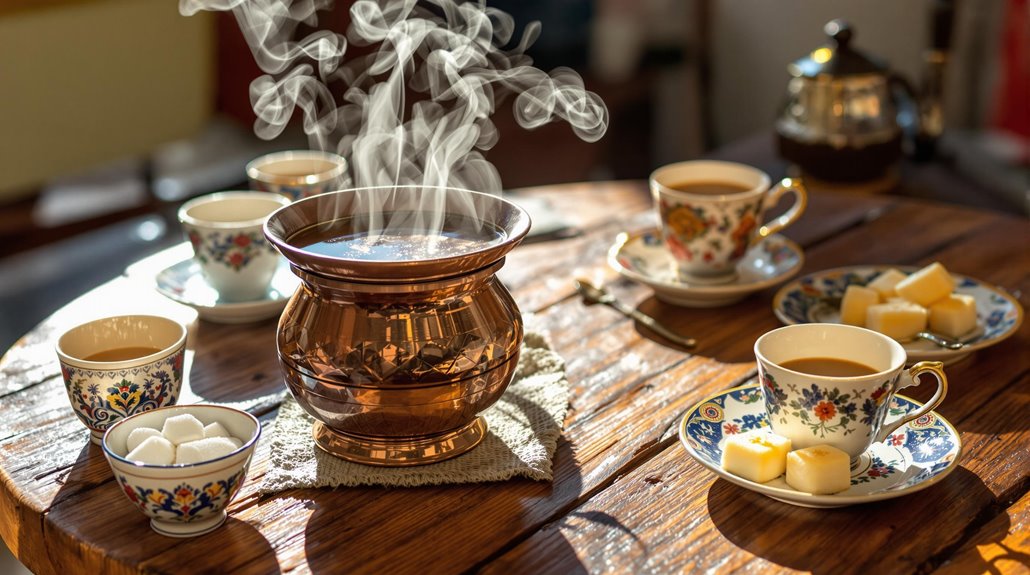





Like a well-crafted poem, Turkish coffee requires precision and care to achieve its rich, layered flavors. You'll want to start with the right ingredients and equipment, ensuring each step in the brewing process reflects the tradition behind this beloved beverage. From selecting the finest coffee grounds to mastering the art of foam formation, every detail matters. But how do you strike the perfect balance between strength and bitterness, and what role does tradition play in your final cup? Let's explore the intricacies that can transform your coffee experience.
Key Takeaways
- Use 2 heaping tablespoons of finely ground Turkish coffee and 1½ cups of cold, filtered water per serving for optimal flavor.
- Heat the cezve over medium heat and watch for dark foam without allowing it to boil to avoid bitterness.
- Gently swirl the cezve to mix ingredients without disturbing the foam; do not stir.
- Pour half of the coffee into cups, return the cezve to heat briefly, then fill the cups to the rim.
- Serve with a glass of water and sweet treats, embracing traditional hospitality and enjoying the rich flavors slowly.
Ingredients for Turkish Coffee
To make authentic Turkish coffee, you'll need a few key ingredients that contribute to its rich flavor and distinctive texture. Start with finely ground Turkish coffee, such as Kurukahveci Mehmet Efendi, which should have a powdery consistency akin to all-purpose flour. This grind is essential for achieving the desired taste and mouthfeel.
Next, measure 1½ cups of cold, filtered water for each coffee cup you plan to serve. Using a Turkish coffee cup guarantees you get the proportions right. For every coffee cup, add 2 heaping tablespoons of ground coffee. Feel free to adjust this based on your preference for strength. If you enjoy a sweeter brew, sugar can be added as desired, ranging from none (sade) to 1-3 teaspoons (şekerli). You might also consider adding spices like cardamom or mastic for added depth.
Finally, combine all these ingredients in the cezve, the traditional pot, before heating. Stirring during the brewing process can negatively impact the foam quality, so make sure everything is well mixed beforehand. This careful preparation sets the stage for a truly authentic Turkish coffee experience.
Brewing Techniques

Brewing Turkish coffee is both an art and a science, requiring attention to detail for the perfect cup. Begin by using about 2 tablespoons of finely ground Turkish coffee per serving, combining it with cold, filtered water in a cezve. Measure the water using the coffee cup intended for serving, ensuring precise proportions.
Next, heat the cezve over medium heat. Watch closely for the formation of dark foam, which is essential for flavor. Remove the cezve from the heat just before it boils to prevent bitterness. To optimize the foam, refrain from stirring once the coffee begins to heat; instead, gently swirl the cezve to mix the ingredients without disturbing the foam.
After the initial boil, pour half the coffee into your cups, then return the cezve to the heat for a few extra seconds. This step helps enhance the flavor and foam. Finally, fill the cups to the rim with the remaining coffee. Serve your Turkish coffee alongside a glass of cold water and sweet treats, creating a delightful experience for you and your guests.
Serving Traditions

While enjoying Turkish coffee, it's important to embrace the rich serving traditions that elevate the experience. Typically, a glass of cold or room temperature water accompanies the coffee, cleansing your palate before savoring the bold flavors of this rich beverage. This practice not only prepares you for the coffee but also highlights its dense nature, as each guest is usually offered just one cup.
Serving Turkish coffee starts with the eldest guest, reflecting the respect and appreciation for social hierarchy in the culture. This tradition emphasizes the significance of hospitality and community, making the act of serving more meaningful.
To enhance your coffee experience, sweet treats like Turkish delights or chocolates are often presented alongside. These confections complement the intense flavor of the black coffee, creating a harmonious balance. It's important to remember that Turkish coffee is traditionally served without milk or cream, maintaining its cultural integrity. As you enjoy this delightful beverage, take your time—Turkish coffee is meant to be enjoyed slowly, allowing you to fully appreciate its depth and the customs that accompany it.
Cultural Significance

Embedded in the heart of Turkish culture, coffee serves not just as a beverage but as an essential social catalyst. The cultural significance of Turkish coffee dates back to the mid-16th century, intertwining with daily life during the Ottoman Empire. Coffeehouses emerged as communal hubs where people engaged in discussions, forged friendships, and exchanged ideas, solidifying coffee's role in social connection.
The preparation and serving of Turkish coffee is a revered ritual, showcasing hospitality and respect. Typically, the eldest guest is served first, emphasizing the importance of tradition and courtesy. In traditional Turkish weddings, the bride-to-be serves coffee, demonstrating her culinary skills and commitment, highlighting coffee's role in significant life events.
Moreover, Turkish coffee transcends mere consumption through practices like tasseography, where the grounds left in the cup are interpreted for fortune-telling. This adds an enchanting layer to the experience, linking the beverage to personal insights and future possibilities. Overall, Turkish coffee embodies a deep-rooted tradition of sharing and bonding, making it an essential component of social life and cultural identity, celebrated in various forms across different regions.
Equipment and Tools

To fully appreciate the social and cultural rituals surrounding Turkish coffee, understanding the equipment and tools used in its preparation is essential. The primary tool for brewing is the cezve, a traditional pot typically crafted from copper, prized for its excellent thermal conductivity. Alternatively, you might choose a stainless steel cezve, which offers durability and ease of cleaning.
The cezve features a wide base, narrow neck, and long handle, allowing for stability during the brewing process. When selecting your cezve, consider the number of servings you plan to make, as they come in various sizes to accommodate your needs.
For the best results, you should use finely ground Turkish coffee, resembling the consistency of all-purpose flour, which is vital for extracting the rich flavors characteristic of this beverage. Brands like Kurukahveci Mehmet Efendi are highly recommended, ensuring you're using high-quality Turkish coffee for an authentic experience.
With the right cezve and finely ground Turkish coffee, you'll be well on your way to mastering the art of brewing this beloved drink, embracing both its flavor and its cultural significance.
Disclosure: As an Amazon Associate, I earn from qualifying purchases.



